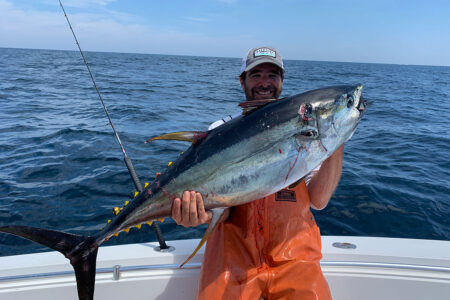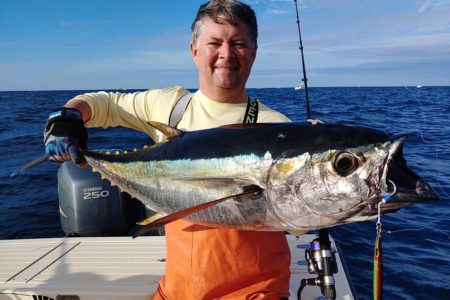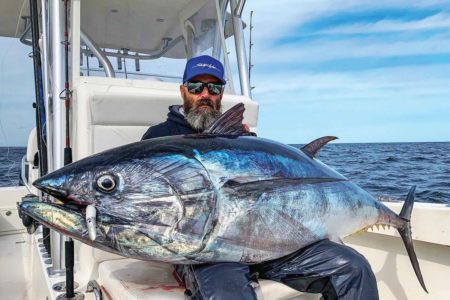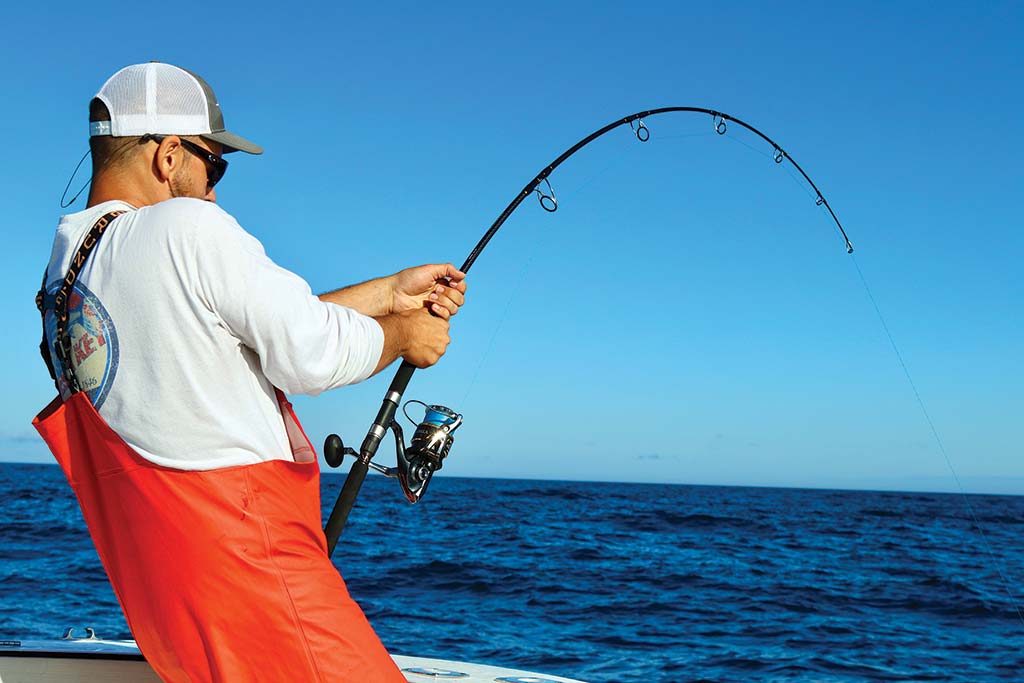
The author shares some hard-earned lessons that should help you improve your tuna game.
Each trip that I take, I try to learn something new. I look back to when I first started chasing tuna and realize that I really knew nothing, but have come a long way. Even though I speak at fishing seminars and write articles about fishing, I spend a lot of free time reading about fishing and attending fishing seminars myself. This article doesn’t focus on just one tactic or technique. Instead of writing about the gear I use, the speed I troll at, my favorite lure, I thought it would be helpful to share with you a few tricks that will actually help you put more fish on the deck.
The Hunt
When I first started looking for tuna, my wife Gina and I would head towards a pre-determined destination. Upon arrival, we would drop our spread in and some days we would catch a few tuna and some days we would draw blanks. It didn’t matter if we saw life or not. After a couple of seasons, I sold my 25-foot Aquasport walk-around and bought a used 28-foot Contender. I had the tuna bug real bad at this point and with a couple of seasons under my belt my confidence began to grow. What I began to realize is that you need to be willing to burn some gas if you want to catch fish on a more consistent basis. Forward a few more years and my tuna bug is now an all-out obsession. I currently have a 31-foot center console. It’s fast and efficient. Last year there was a day that we headed towards the Coimbra Wreck, one of the Northeast’s more consistent tuna spots the past few years. Once we got there, I saw no signs of life. On top of that, there were tons of boats already belly aching on the radio that they weren’t catching anything. As I slowed my boat to look, my crew popped up from their bean bags expecting us to start dropping our spread in. I told them to take a seat; we had some hunting to do before we could fish. I pointed the boat southwest and off we went. We put about 40 miles of ocean behind us and found what we were looking for. I don’t know if I had ever seen that many whales in one location. Within five minutes of lines in, we had our first yellowfin tuna on the deck and we could have caught as many as we wanted. You know it is time to go home when guys on the boat start arguing over who doesn’t want to reel the next fish in. Ten minutes into the ride home, my crew was passed out. As for me, the giant smile on my face gave me comfort that I had made the right call. I wish I had learned this lesson a long time ago. By the way, the bite at the Coimbra never materialized on that day. I know you need to head towards a destination when you break the inlet, but it doesn’t mean you should stay there once you arrive.
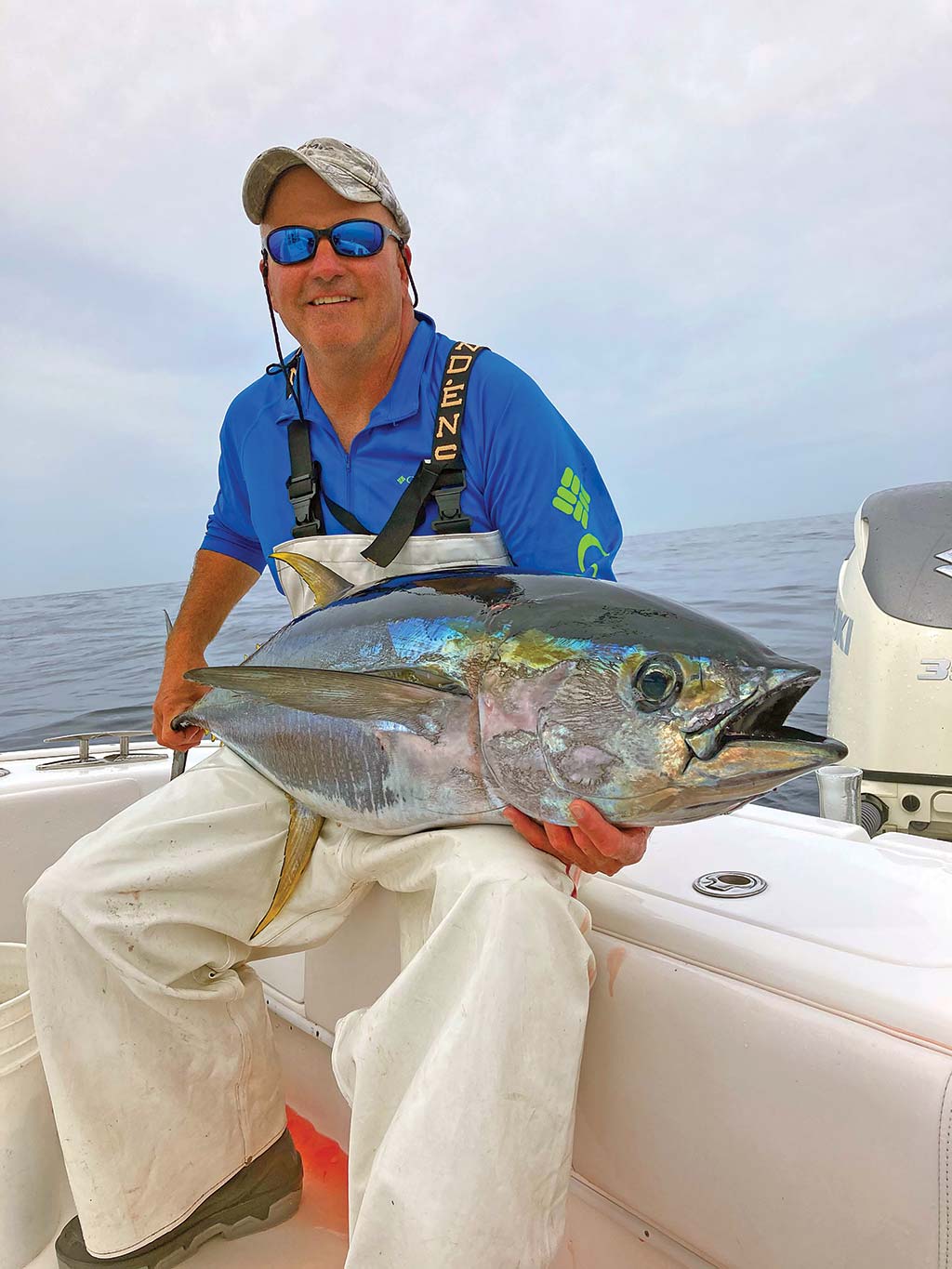
Get Off The Troll
Trolling can be a very relaxing way to fish. Along with being relaxing, you are able to cover a lot of ground searching for fish. However, there are times when it just makes a lot of sense to put the trolling gear away and start to jig and pop. Once we hook up, or have pinpointed where the bait and fish are located, we put away our trolling gear and start to jig and pop. Sometimes it is all “unders,” but just because we are catching “unders” it doesn’t mean that bigger fish aren’t among them. On one trip last season, the weather was so nice there was really no reason to leave so I checked with my crew and everyone was good to keep fishing. We headed out in the dark and we were about two hours from heading home in the dark when I noticed a school of small skipjack tuna on the surface. I remembered reading that big bluefin and yellowfin will often hang underneath schools of skipjack tuna. As I’m heading over to the skippies, my buddy who was fishing within eyesight of us hails me on the radio and tells me they just had a big bluefin come up and “nose” a popping plug. That got me excited so I grabbed a popping outfit and handed it to my buddy Chris. While he worked the popper, the other guys continued to jig. I just stared at the popper as Chris worked it along the surface and then it happened. A huge fish exploded on the plug right in the middle of the school of skipjacks. This was the fish we were looking for – I estimated it to be in the 150 to 200-pound range and it ripped off line for 15 straight seconds before coming unglued. As we headed home, I played out the day in my head. It was a good feeling knowing that the things I have learned continue to make me a better angler. Of course, I would have loved for us to have landed that fish but we were able to ride home with the setting sun rather than complete darkness. The next time you encounter a school of skipjack tuna, I suggest you start popping until you are exhausted and then pop a little more.
Matching The Hatch
I have written articles about “matching the hatch” on several occasions. I believe that ideology is one of the core fundamentals when it comes to fishing. When you buy a jig that matches the colors of a sand eel it is because you will be fishing areas where tuna are feeding on sand eels. I get very frustrated when I buy a popper or a jig and after a good day of fishing the lure no longer looks like the lure that I had purchased. I have tried to paint them on my own. I even went to Michael’s (craft store) and bought some glitter tape that I wrapped around the jigs. Both ideas were a complete waste of time and money. However, I have good news if you feel the way I do.
Check out the products sold by Jigskinz. They developed a sleeve that goes over your popper or jig. It turns an old lure into one that looks brand new and all that is needed is boiling water. This is the ultimate advancement in the world of “matching the hatch.” For just a couple of bucks, you can revitalize some of your favorite lures and make them look as good, or even better than new.
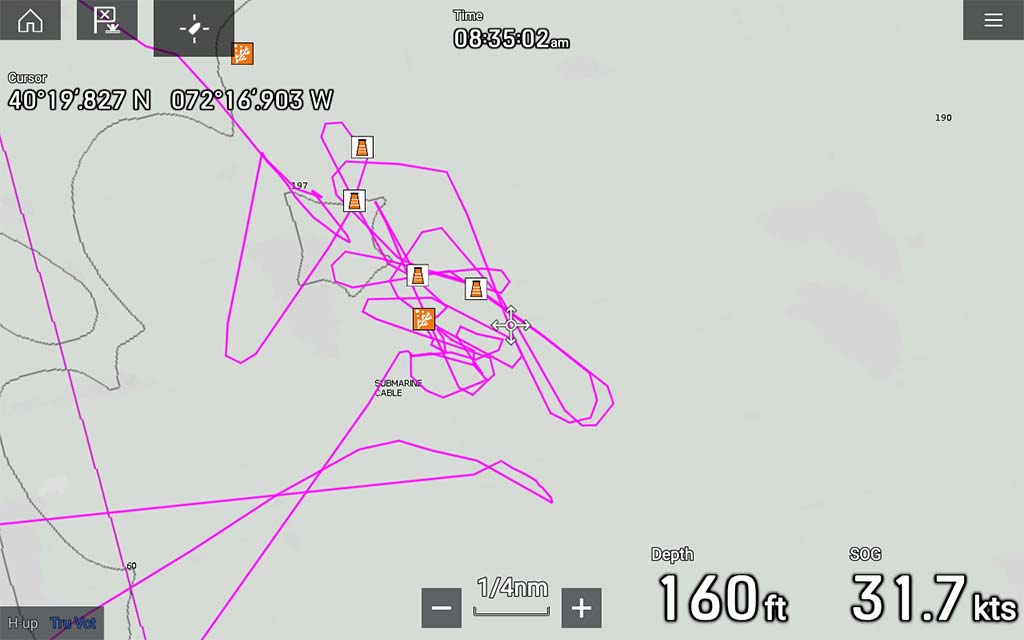
When To Troll
Here is an instance where it was better to stop jigging/popping and start trolling. Last year we found ourselves fishing near another well-known wreck, the Bacardi. It was flat calm conditions under a bright sun, and we quickly found a school of nice size bluefin tuna “sunning” themselves on the surface. We threw everything (RonZs, poppers, stick baits) at them. We even sent down jigs. They wanted nothing to do with us. I’m standing on the bow watching 100 to 150-pound bluefin right next to the boat swimming in circles. It was one of the most frustrating moments I have ever experienced while fishing. When I leave the dock, I am so focused on finding fish it never enters my mind that they may not want to feed when we do find them. The crazy part is the fact that these fish were not getting spooked and seemed to be in a trance.
After about an hour, I gave up. At this point, I decided to troll around as a way to collect my thoughts and give everyone some time to relax. Just because I decided to troll didn’t mean I was done trying to catch those fish. I’m way too stubborn to just drive away. I marked the spot and I headed away from the fish. Once we had the spread out it was time to turn around and get on them. With slick calm conditions, the use of my binoculars made it easy to see that the fish were still in the same spot. Four times, I dragged a wide-tracker past the school and nothing! I felt like a five-year-old when he doesn’t get what he wants. Out of pure frustration, I decided to run the boat directly over the fish. One of the first things you learn about fishing a school of fish on the surface is never drive over them because you end up pushing the fish down. As we were about 100 yards past where we ran the fish over, it happened. One of our starboard purple wide-trackers gets crushed. About 20 minutes later, we had a 120-pound bluefin on the deck. A few weeks later, we would encounter the same thing with several schools of yellowfin tuna and running over them produced fish after fish.
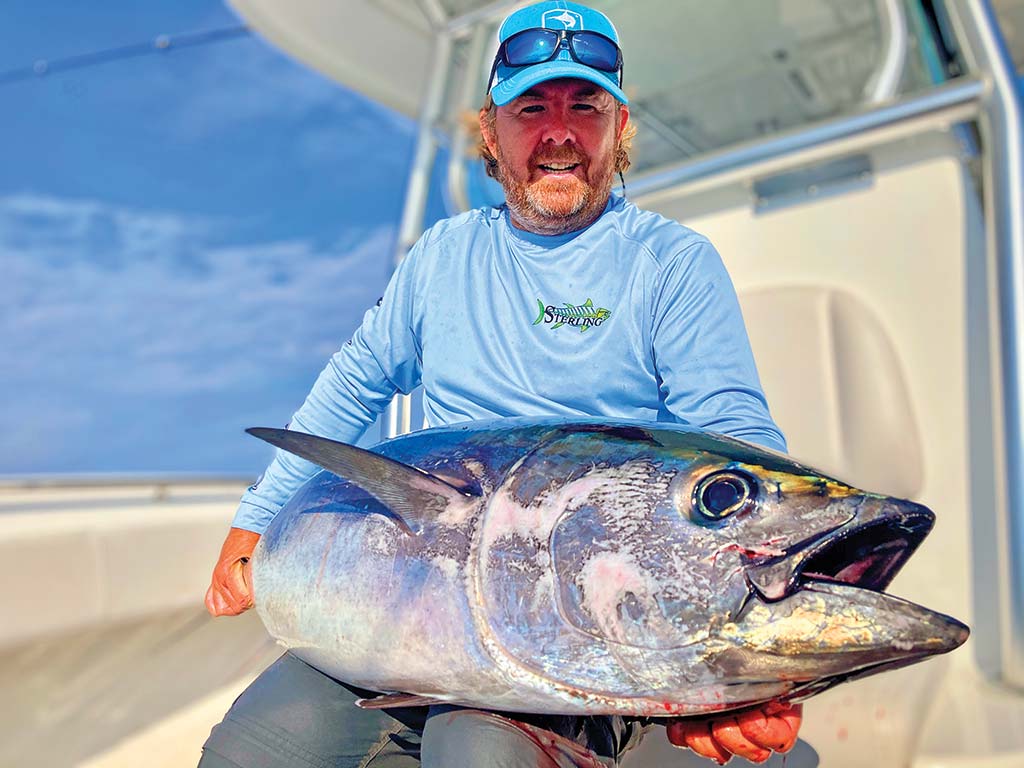
Draggers And Tuna
If you are just getting into the game, trolling and jigging behind commercial draggers can be very rewarding. If you cannot find fish, a dragger on the horizon is always a welcome sight. These draggers act as constant chum machines and quite often tuna will feed in their wakes. There are a few ways to fish behind them. You can jig, troll or use natural bait; we will focus on trolling here.
A few years ago, I found everything you could hope for – whales, dolphins, birds and bait. I could not believe we weren’t hooking up. I realize that I sound like Captain Obvious but you cannot catch fish that are not there. As I am thinking about my next move two guys start a conversation on the radio. It turns out that one of them had been catching rat sized (10 pounds) bluefin behind a dragger. He was leaving to look for bigger fish. There was only one dragger within eyesight so I steered in its direction. I have no desire to catch rat-sized bluefin. However, I felt that if the dragger is holding small bluefin, conditions were good enough to hold some larger fish. I entered the dragger’s slick from about 500 yards behind his stern as if I’m stalking it. On the fish finder, I can see that there are fish under the boat but nothing is coming to the surface. I decided to give it one last try before switching over to jigging. I looped back and came around for another pass, and once again, I see fish under the boat. This time I put the boat in neutral. In my spread were three Joe Shutes rigged with ballyhoo. I waited about ten seconds to allow them to sink, and then I bumped the throttles back up to trolling speed. Within five seconds, our long rod starts to sing. I’m glad that we are hooked up but I keep thinking it’s a small bluefin. Gina is fighting the fish while I am clearing lines. Gina weighs only 115 pounds, so even a small fish can seem big. As I watch her fight this fish I realize that it ate a Joe Shute. That means that the Joe Shute, unlike a fish on a wide-tracker, is creating very little drag. After 20 minutes, the fish is boat side and it’s not huge but it certainly isn’t a rat. It ends up being 60 pounds. I have used this trick multiple times since then. You don’t need to be behind a dragger to do this. Our two biggest bluefin to date have been caught using this little trick.
If you are open minded and willing to learn you will be amazed at how the littlest things can turn an uneventful day into a memorable one. One last thing. If you really want to be successful on the water, you as the captain must be confident, and your crew should be hard working and positive. Sometimes that bite does not come until late in the day. Remember that some of your best and most memorable fishing days will not always come easy.

